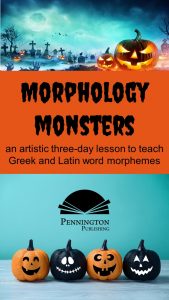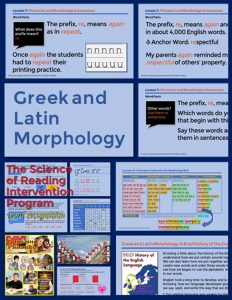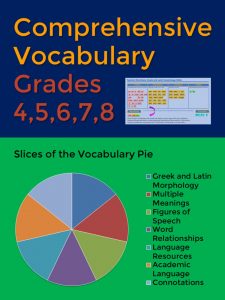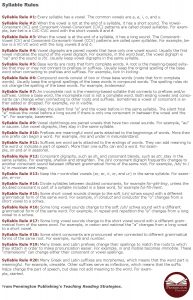
Comprehensive Vocabulary
Following is a research-based argument as to why vocabulary word lists don’t work for vocabulary acquisition.
Most of us would agree with reading researchers that vocabulary development is critically important to improving reading comprehension (e.g., Anderson & Freebody, 1981; Baumann, Kame‘enui, & Ash, 2003). However, not all vocabulary instruction is effective or efficient.
The Weekly Vocabulary Word List
In many classrooms the predominant means of vocabulary instruction is weekly vocabulary word list. Pass it out on Monday; have students look up and write down definitions, make game cards, do a crossword puzzle, do a word sort, write context clue sentences, etc. Then test on Friday. The problem is that this approach does not work. It’s ineffective and inefficient.
It’s ineffective.
Students memorize the list for the Friday test and forget half of them by the next week. “Rote memorization of words and definitions is the least effective instructional method resulting in little long-term effect (Kameenui, Dixon, Carine 1987).”
It’s inefficient.
Even if students were to remember all of the, say 20 words, on the weekly vocabulary word list for the entire school year, they would only have mastered 600 words. But, the American lexicon is over 800,000 words. The SAT® word bank is over 30,000. 600 words won’t make a dent in those numbers.
According to reading research, students need to learn 3,000 new words per year just to make year-to-year grade level progress (Honig 1983). So learning only 600 words is a very small drop in a very big bucket. But it is a bucket we desperately need to fill-especially for educationally disadvantaged students, whose “word poverty” (Louisa C. Moats) dooms them to the “Matthew Effect” (Keith Stanovich) in which the poorer tend to get poorer.
To teach students 3,000 words a year, students would have to learn 17 words each school day (3,000 words over 178 school days). However, classroom intervention studies suggest that only 8 to 10 words can be retained through direct instruction in one week (Stahl & Fairbanks, 1986). That works out to about 300 words per year-hardly enough.
So, if vocabulary word lists are ineffective and inefficient. What does work to teach those 3,000 words per year?
Three Effective and Efficient Methods of Vocabulary Instruction
1. Independent Reading
Let’s use Luis as our example. Reading 30 minutes per day for homework at a rate of 200 words per minute, for a total of 132 days (4 days per week in a typical school year), means that Luis would be exposed to 792,000 words (30 x 200 x 132). If Luis reads text at the recommended 5% unknown words* level of word recognition recommended by reading researchers (Stahl, 1999), this means that he would be exposed to 39,600 unfamiliar words per year (792,000 x .05). Because students learn between 5 and 10 percent of previously unknown words in a single reading (Stahl, 1999), Luis will have learned between 1,980 and 3,960 new words at home! Not to mention reading in class.
*That 5% unknown words level is critically important. If students read texts below their current reading levels, even lots of reading won’t result in measurable vocabulary growth (Carver, 1994).
However, the vocabulary gleaned from independent reading is almost exclusively Tier 1 vocabulary. Students need the academic language of Tier 2. So…
2. Greek and Latin Word Parts
Reading researchers suggest that learning Greek and Latin word parts is an effective and efficient method for acquiring vocabulary (e.g., Anglin, 1993; Biemiller & Slonim, 2001). Over 50% of all academic vocabulary contains one or more Greek or Latin prefix, root, or suffix. Unlike memorizing vocabulary word lists, memorizing word parts produces enormous pay-offs because one prefix, root, or suffix may be a component of hundreds of words. Learning these word families provides significant utility for the reader, especially those word parts with the highest utility.
Just 9 prefixes constitute 75% of words with prefixes (White, Sowell, & Yanigihara, 1989). Comprehensive frequency studies have not been completed on roots; however, there is general consensus as to utility of a few hundred roots. There is less agreement on the value of teaching suffixes. Suffixes can often have vague meanings such as “the state of”; suffixes are often merely inflectional forms; they also tend to vary spellings. However, some study of suffixes that have specific meanings is certainly warranted. Check out a great list of Greek and Latin word parts for instruction here.
3. Tier One, Two, and Three Words (Beck et al., 2002)
Some words do not need to be taught. Tier One Words are high utility words that will become part of a student’s lexicon incidentally through oral language or reading. Tier Two Words are common words used in cross-curricular academic discussions and reading. Tier Three Words are the specific-to-the-subject words that can sometimes be learned through effective application of context clues, but more often than not require vocabulary instruction in depth.
For example, examine this sentence: The happy child was fortunate to have such a sunny disposition.
Tier One Words: happy, child, sunny
Tier Two Word: fortunate
Tier Three Word: disposition
*****
For full-year vocabulary programs which include multiple meaning words (L.4.a.), Greek and Latin morphology with Morphology Walls (L.4.a.), figures of speech (L.5.a.), words with special relationships (L.5.b.), words with connotative meanings (L.5.c.), and academic language words (L.6.0), check out the assessment-based grades 4, 5, 6, 7, and 8 Comprehensive Vocabulary.
Get the Grades 4,5,6,7,8 Vocabulary Sequence of Instruction FREE Resource:

Get the Greek and Latin Morphology Walls FREE Resource:

Get the Diagnostic Academic Language Assessment FREE Resource:

ats).
Reading, Spelling/Vocabulary
context clues, Greek and Latin, Mark Pennington, prefixes, roots, SAT words, suffixes, syllables, vocabulary, vocabulary word lists





